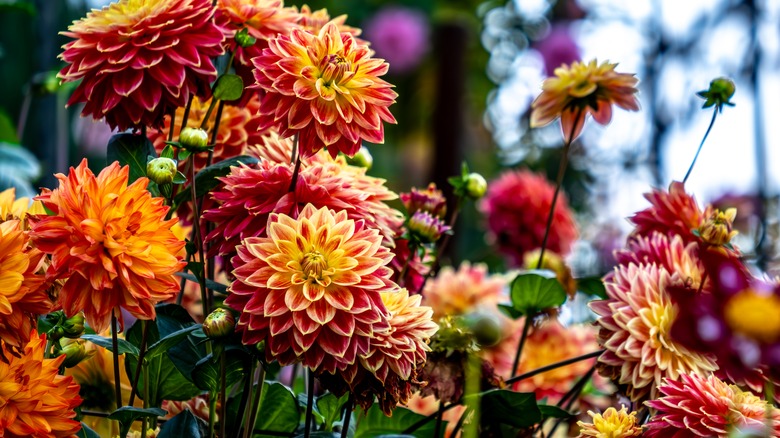The Big Mistake You May Be Making When Growing Dahlia Tubers
Is there anything more eye-catching than a gorgeous dahlia in full bloom? These beautiful plants are so generous when it comes to producing their stunning flowers all summer long. They'll fill your garden with the most brilliant color, especially if you follow Martha Stewart's top tips for growing beautiful dahlias year after year. Growing these beauties is not that difficult, but there's a big mistake you may be making when growing dahlia tubers — digging up a clump, seeing a whole bunch of fleshy tubers, and assuming you've hit the jackpot. The truth is that not all the tubers you might be looking at will grow into new plants.
To explain, dahlias may produce two different types of tubers during their growth. First, there are the lovely, fleshy parts that are near the base of the existing plant. These are usually the viable tubers that will produce a new plant and plenty of those glorious flowers. But, you might also notice some more fleshy growths further down that are closely attached to the main tuber. These are known as feeder tubers and are purely energy storage organs that are there to provide the plant with nutrients and moisture to continue to grow.
These feeder tubers will not produce a new plant because that's simply not their purpose. In fact, you can just cut these off and discard them, as shown in the clip below from Instagrammer 80milesnorth. You can do this before or after storing your tubers to protect your dahlias from the cold winter weather.
How to distinguish viable tubers from feeder ones
For a dahlia tuber to be viable, it must have three distinct parts: the plump tuber section that looks similar to a sweet potato, a short or long neck at the top, and a piece of crown. The crown is the lumpy section at the very top, which was the base of the previous year's growth that has died back. It's from this crown that new eyes will develop to produce the new season's flowers. Viable tubers will always grow at the base of the stem from the previous season's growth.
On the other hand, feeder tubers are just energy reserves that the plant has produced to feed its continuing growth. With closer inspection, you'll notice that many of these don't have a neck and are firmly attached to the main tuber, while others may have a short neck but no crown for a new eye to grow from. Remember that the crown is the base of the previous season's growth, and it's only this part that has the capacity to produce the "eyes" that a new plant can sprout from.
While it's not essential to remove the feeder tubers, it's a good idea to do so, according to experienced dahlia growers, because if a tuber has too much energy stored, it will be much slower in producing new feeder roots. Finally, before you replant them, you should also know that planting dahlia tubers vertically is a big mistake, and how to do it correctly.
